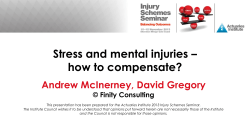
Iliotibial Band Friction Syndrome Demystified
Iliotibial Band Friction Syndrome Demystified By: Dr. Jason A. Pajaczkowski Injuries. They are par for the course, rights of passage if you will, for the endurance athlete. From the Law of Repetitive motion, we know that cyclic, recurrent actions result in overuse injuries as tissue damage outpaces the bodies normal repair process. We have all experienced the occasional transient tweak or strain as the result of a particularly grueling week of training. In fact, 70% of runners sustain overuse injuries during any 1-year period.(1) However, those of us who have dealt with Iliotibial Band Friction Syndrome (ITBFS) are forever haunted by its tenacity and penchant for brining your runs to a complete stop. Studies have found ITBFS to be the second most common running injury behind patellofemoral pain syndrome, yet despite its prevalence, management of this condition has proven to be somewhat of an enigma.(2) While we have identified a number of biomechanical and physical factors that predispose runners to ITBFS, current research has yet to fully elucidate and validate a therapeutic intervention. This is in large part due to the complex nature in which the aforementioned factors of this condition interact. By piecing together our knowledge of anatomy, biomechanics and rehabilitation, we have identified certain commonalities that mediate this condition, and used this information to formulate a successful prevention and management system for ITBFS. The iliotibial band (ITB) is an extremely strong band of fascia (a form of connective tissue) that runs from the top of the pelvis, down the outside of the leg, before eventually inserting onto the tibia, fibula, and patella. Excessive tension or stress within the ITB causes it to rub excessively over the femur just before it crosses the knee. The abnormal forces, via friction and tension, results in local fibrotic degneration of the ITB (see last month’s Transition for the “Dispelling the myths about tendon injuries and treatment” article), resulting in local burning, aching pain and palpatory tenderness on the outside of the knee every time it is bent or straightened out. Aggravating exercises include walking up and down stairs, running and cycling. Without proper care, it takes an average of four weeks before the severity of the symptoms and the rapidity of their onset makes your workouts an insurmountable task. Given that excessive tension appears to be the universal factor in ITBFS, therapeutic management and prevention should focus on minimizing it by stretching the ITB, releasing it from the underlying vastus lateralis (quadriceps) muscle, and strengthening the gluteus medius and psoas muscles at the side and front of the hip, respectively: • Adhesion of the ITB to the vastus lateralis would force it to stretch and pull with every contraction of that muscle, rather than allowing it to move independently over top. Complete and effective removal of these adhesions or scar tissue is not possible through self-treatment, and should only be performed by a practitioner trained in Active Release Techniques®. • The most effective ITB stretch is performed in the standing position by crossing the affected leg over the non-symptomatic one, and reaching the arm on the affected side overhead while bending the trunk away from the symptomatic side.(Photos A and B) This should be held for 30 seconds, and performed 2-3 times per day.(3) • Weakness of the gluteus medius muscle causes the hip on that side to push out against the ITB, similar to pulling the string on a bow. Weakness of the gluteus and psoas muscles has been identified in runners with ITBFS, while strengthening of this muscle has had tremendous success in treating ITBFS, boasting cure rates greater than 90%.(4,5) This can be accomplished by performing side-steps with a resistance band tied around your ankles (Photo C), hip hikes (affected leg standing on an up-going step, the athlete drops the opposite hip down and then raises it as high as possible) (Photos C and D), and pelvic bridges with a resistance band around your knees (lying on their back, hips flexed 45° and knees bent 90°, the athlete raises their torso off of the floor so that thigh and the trunk are now in a straight line). • In-office therapies such as laser, microcurrent, ART® and medical acupuncture are extremely effective tools that rapidly accelerate the healing of this condition. They should be utilized in conjunction with the aforementioned exercise program. These exercises are safe and effective as a preventative measure, but should never be a substitute for a proper evaluation by a qualified and licensed sports specialist. Remember that overuse injuries occur as the result of faulty movement patterns, and even though the pain may be modulated the underlying pathological pattern, which instigated this process, may not. In addition, you should have your training program monitored regularly as more than 60% of all running injuries are the result of training errors.(1) 1. Hreljac A. Impact and Overuse Injuries in Runners. Med Sci Sports Ex. 2004 36(5):845-9. 2. Taunton JE, Ryan MB, Clement DB, McKenzie DC, Lloyd-Smith DR, Zumbo BD. A retrospective case-control analysis of 2002 running injuries. Br J Sports Med. 2002 Apr;36(2):95-101. 3. Fredericson M, White JJ, Macmahon JM, Andriacchi TP. Quantitative analysis of the relative effectiveness of 3 iliotibial band stretches. Arch Phys Med Rehabil. 2002 May;83(5):589-92. 4. Niemuth PE, Johnson RJ, Myers MJ, Thieman TJ. Hip muscle weakness and overuse injuries in recreational runners. Clin J Sport Med. 2005 Jan;15(1):14-21. 5. Fredericson M, Cookingham CL, Chaudhari AM, Dowdell BC, Oestreicher N, Sahrmann SA. Hip abductor weakness in distance runners with iliotibial band syndrome. Clin J Sport Med. 2000 Jul;10(3):169-75. Pictures Side-Step – Starting Position (Photo A) Side-Step – Finishing Position (Photo B) ITB Stretch (Photo C) Hip Hike – Starting Position (Photo D) Hip Hike – Finishing Position (Photo E)
© Copyright 2025





















